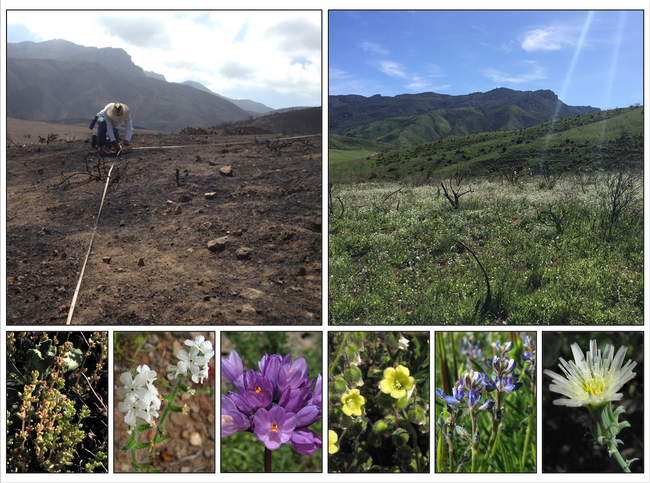Wildfire is an important ecological process that shapes patterns of plant diversity in many Mediterranean ecosystems, including California. In coastal sage scrub and chaparral, for example, plant diversity is often highest in the growing seasons immediately after a site burns, with many fire-following species emerging from the soil seed bank and bud bank. This often results in spectacular displays of wildflowers when sufficient rainfall occurs following fire.
In a recent study published in Global Change Biology, however, we found that persistence of these unique, fire-following wildflowers may be threatened by invasive plant species as well as nitrogen deposition which results from air pollution. In areas with high levels of air pollution, large amounts of nitrogen exit the atmosphere, ending up in the soil and essentially fertilizing ecosystems. Previous research has shown that this added nitrogen promotes weedy nonnatives over native plant species, but the impact on post-fire plant diversity was relatively unexplored.
Working with the National Park Service in the Santa Monica Mountains of southern California, we conducted a multi-year nitrogen fertilization experiment in coastal sage scrub shrublands that burned in the 2013 Springs Fire. We fertilized plots with different levels of nitrogen that correspond to the range of nitrogen deposition experienced by sites in the Los Angeles region. We monitored plots for several years with the goal of understanding how nitrogen pollution impacts post-fire recovery and plant diversity.
We found that plant diversity was highest in the early years of the study – due to the presence of many wildflower species – and gradually declined. However, nitrogen addition hastened this process, and overall plant richness was significantly reduced in plots receiving high levels of nitrogen. This was caused by increased growth of weedy plant species, especially Shortpod Mustard (Hirschfeldia incana), in these plots. Our analysis also indicated that a variety of native fire-following species were especially vulnerable to nitrogen addition. While nitrogen deposition is a well-recognized threat to plant diversity worldwide, this research highlights a new potential mechanism for species loss through impacts on fire-following plant species. Effective weed management and post-fire restoration may be necessary to protect this important component of biodiversity under ongoing environmental change in California.
